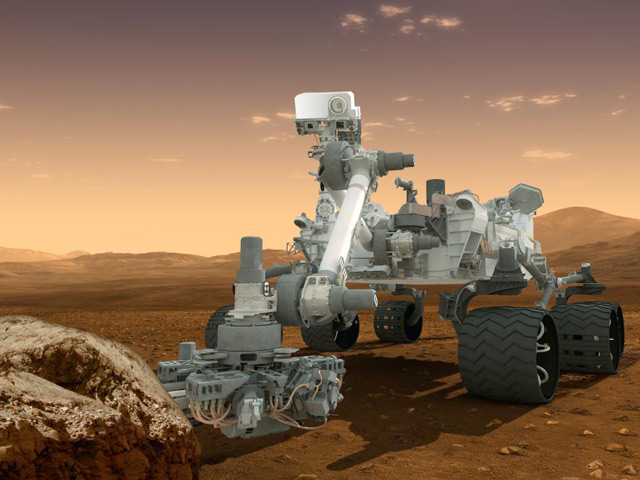
This artist's concept features NASA's Mars Science Laboratory Curiosity rover, a mobile robot for investigating Mars' past or present ability to sustain microbial life. Image credit: NASA/JPL-Caltech.
NASA is planning a new addition to the fleet of satellites and rovers circling Mars in advance of a hoped-for human visit in the 2030s. The space agency announced Dec. 4 that the Mars Science Laboratory rover Curiosity, currently searching for signs of past (or present) life on Mars, will provide the basis for designing a new rover to be launched in 2020—including a landing system that succeeded ) in completing the perilous journey back in August using a combination of rockets and parachutes to control the final descent.
NASA said using this proven technology will reduce both the cost and risk that comes with delivering a new set of instruments to the Martian surface. The new rover’s science mission is not yet decided, but may include collection of samples for return to Earth.
“The challenge to restructure the Mars Exploration Program has turned from the seven minutes of terror for the Curiosity landing to the start of seven years of innovation,” NASA’s associate administrator for science (and astronaut) John Grunsfeld said in a news release. “This mission concept fits within the current and projected Mars exploration budget, builds on the exciting discoveries of Curiosity, and takes advantage of a favorable launch opportunity.”
Budget, of course, may be an issue. NASA said plans for the new rover, along with other elements of the Mars plan, are contingent on future funding penciled in by the White House but yet to be approved by Congress.
Mars will be a little more crowded by the time the next rover arrives. In addition to three satellites already orbiting the planet—two launched by NASA and a third by the European Space Agency—NASA plans to launch in 2013 an orbiter to study the Martian upper atmosphere, followed by a lander dubbed InSight in 2016 that is designed to measure seismic and other characteristics of the planet’s interior.
NASA will also collaborate with ESA on European Mars missions planned in 2016 and 2018.
The ultimate goals, including sample return missions and human visits to the Red Planet, are detailed in the report of the Mars Program Planning Group delivered in September. Additional details about past, present, and future Mars missions are available on the NASA website.



